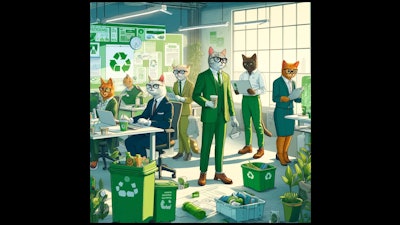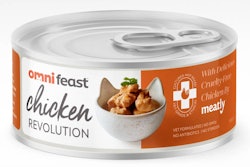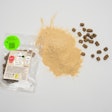
Pet owners pay attention to sustainability claims on pet food products when purchasing new products. When developing new pet foods and treats, their production’s ecological and social ramifications must be considered to address pet owners’ environmental and egalitarian concerns. Pet food professionals discussed the benefits of baking sustainability into the recipe during the new pet food product development process, during the Ask the Pet Food Pro panel discussion: Making sustainable pet food at Petfood Forum 2024 in Kansas City, Missouri. Jim Lamancusa, executive director of the Pet Sustainability Coalition, hosted the discussion.
Question: When developing new products, where does the role of sustainability come in? And what are the challenges and benefits to including it in the process?
Shannon Landry, pet brand manager, Packaged Facts
One of the biggest issues right now, in terms of what consumers are looking for, is value. As part of our consumer surveys, we asked consumers, are you willing to pay more for a sustainable product versus I can't afford to live sustainably right now. Right now, it's it's about a third of consumers agreeing with the former and about a third agreeing with the latter. Price points are big. Focusing on how sustainability ties into value is going to be incredibly important. That would be one of the primary concepts to have in mind, just not so much focusing on price, but how the sustainability efforts are helping the consumer, helping their pets, helping the planet, that kind of thing. Another issue to keep in mind is letting consumers know what sustainability is, what it means, and what your efforts are accomplishing. We ask a question, "What does it mean to live sustainably?" The vast majority of people respond positively to things like “recycling when I'm able,” and “purchasing products that are made out of recycled content when I'm able.' Fewer think in terms of the ingredients that go into their pet foods. Consumer education is going to be important when it comes to that.
Brian Steinwagner, executive vice president with sustainability responsibilities, Morris Packaging
Everything that we've worked on recently definitely has all the sustainable background focused on it. But we've done it a different way, we've kind of started at the back and work forward. We've designed our materials to run on our customers' equipment first. That's got to be a priority. Whatever we supply has to be able to run at the same speeds that they're currently running at, doesn't account for any more waste, and operationally it fits in their system without causing problems. We work that end first and ensure we've solved that before we bring the structure to present them with. We work with a lot of the filling equipment initially to make sure that we don't disrupt the production end before we say, 'here's the structure, this is what you need to run.'
Adam Craig, director of product development, Hill’s Pet Nutrition
As we talked about product design, and this is one of my main focus areas at Hill's, is if your carbon footprint is one of your primary focus areas, from a sustainability point of view, it's important to know that if you look across scope, one, two and three emissions for pretty much any pet food company, over half of your carbon footprint will be coming from your raw materials, ingredients that go into your food. Product design has a huge role. If you break down that bucket of ingredients because at the end the day, obviously, we still need to use ingredients. You can't make food without them. It's a unique challenge of how do we really impact our carbon footprint coming from something that is such an integral part of what we put out in terms of finished product. If you dig into that bucket of raw materials a little further, animal proteins and grains will be your two biggest drivers for most pet food products. The reality is not all proteins have the same carbon footprint. Not all grains have the same carbon footprint. There's opportunities even within the design of your food that can have a drastic impact on the carbon footprint of that finished product. Then, it's also partnering with your suppliers to think through how we can source some of our existing materials through alternative farming practices that can actually lower carbon emissions. There are a lot of opportunities in this space that we'll need to all work together at the industry level, between manufacturers and suppliers, to really get the traction we need to make an impact.
Elizabeth Maier, director, growth and innovation, Wilbur-Ellis Nutrition
Because we're the supplier, the brand depends on us to think about this before asking us for the product they're developing. We actually need to be ahead of this. Yet typically, we are a little bit behind in the supplier realm. I look at this two ways. We need to be looking at the inputs. What ingredients are we working with, to begin with? Are those inherently sustainable? He was saying that each one of them have their own different stories. It's about getting smarter, about looking for efficient things to use. I've always loved that about animal feed and food, that we are inherently sustainable because we're usually using co-products that would go to waste from human food. As often as we can work with that, that's a good way to go. You've got the input side, but then you also have the output side. How are we improving waste on the back end? It's easy to think about putting the product into the market, but what happens after it gets out there? In the livestock world, they think about feed efficiency. We can be thinking about that for pets, too. We can be very aware of how what we're putting into these animals' bodies is good for them. It's good for the environment, and it's good for the future of everything.
Stephie Volo, chief impact officer, Earth Animal
As the chief impact officer, I work with all departments in our company, we have an integrated sustainability strategy throughout the company. Therefore, I work with all departments. One incredible resource and tool that we can provide to all of our partners, no matter where they are in the supply chain, is a partner code of conduct, which really describes what is most important to our company when it comes to our partners. It actually describes what your expectations are when it comes to things like a living wage and how they are treating their employees. It talks about sustainable sourcing guidelines. That's what's really important. That's what suppliers need, whether they are packaging suppliers focused on biodiversity and deforestation or recyclability, or ingredient suppliers focused on the same things along with nutrition and animal welfare. Sustainability really can plug in anywhere. But the most effective, is at the beginning so that suppliers don't have any questions about what are the company's expectations, no matter where you are in the supply chain. It can be a brand. It can be a distributor or retailer. What are your expectations?


















